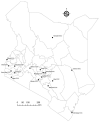Adapting Longstanding Public Health Collaborations between Government of Kenya and CDC Kenya in Response to the COVID-19 Pandemic, 2020-2021
- PMID: 36502403
- PMCID: PMC9745212
- DOI: 10.3201/eid2813.211550
Adapting Longstanding Public Health Collaborations between Government of Kenya and CDC Kenya in Response to the COVID-19 Pandemic, 2020-2021
Abstract
Kenya's Ministry of Health (MOH) and the US Centers for Disease Control and Prevention in Kenya (CDC Kenya) have maintained a 40-year partnership during which measures were implemented to prevent, detect, and respond to disease threats. During the COVID-19 pandemic, the MOH and CDC Kenya rapidly responded to mitigate disease impact on Kenya's 52 million residents. We describe activities undertaken jointly by the MOH and CDC Kenya that lessened the effects of COVID-19 during 5 epidemic waves from March through December 2021. Activities included establishing national and county-level emergency operations centers and implementing workforce development and deployment, infection prevention and control training, laboratory diagnostic advancement, enhanced surveillance, and information management. The COVID-19 pandemic provided fresh impetus for the government of Kenya to establish a national public health institute, launched in January 2022, to consolidate its public health activities and counter COVID-19 and future infectious, vaccine-preventable, and emerging zoonotic diseases.
Keywords: CDC; COVID-19; Centers for Disease Control and Prevention; Global Health Security Agenda; Kenya; PEPFAR; SARS; SARS-CoV-2; bilateral partnership; coronavirus; coronavirus disease; emerging disease outbreak response; global health security; respiratory infections; severe acute respiratory syndrome coronavirus 2; viruses; zoonoses.
Figures



References
-
- World Health Organization. WHO Director-General’s opening remarks at the media briefing on COVID-19—11 March 2020. [cited 2021 Jul 2]. https://www.who.int/director-general/speeches/detail/who-director-genera...
-
- World Health Organization. WHO coronavirus (COVID-19) dashboard [cited 2022 Nov 20]. https://covid19.who.int
Publication types
MeSH terms
LinkOut - more resources
Full Text Sources
Medical
Miscellaneous

